
Siege tower
Encyclopedia
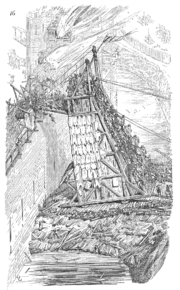
Siege engine
A siege engine is a device that is designed to break or circumvent city walls and other fortifications in siege warfare. Some have been operated close to the fortifications, while others have been used to attack from a distance. From antiquity, siege engines were constructed largely of wood and...
, constructed to protect assailants and ladders while approaching the defensive walls of a fortification
Fortification
Fortifications are military constructions and buildings designed for defence in warfare and military bases. Humans have constructed defensive works for many thousands of years, in a variety of increasingly complex designs...
. The tower
Tower
A tower is a tall structure, usually taller than it is wide, often by a significant margin. Towers are distinguished from masts by their lack of guy-wires....
was often rectangular with four wheels with its height roughly equal to that of the wall or sometimes higher to allow archer
Archery
Archery is the art, practice, or skill of propelling arrows with the use of a bow, from Latin arcus. Archery has historically been used for hunting and combat; in modern times, however, its main use is that of a recreational activity...
s to stand on top of the tower and shoot into the fortification. Because the towers were wooden and thus flammable, they had to have some non-flammable covering of iron or fresh animal skins. The siege tower was mainly made from wood but sometimes had metal parts.
Used since the 9th century BC in the ancient Near East, the 4th century BC in Europe
Europe
Europe is, by convention, one of the world's seven continents. Comprising the westernmost peninsula of Eurasia, Europe is generally 'divided' from Asia to its east by the watershed divides of the Ural and Caucasus Mountains, the Ural River, the Caspian and Black Seas, and the waterways connecting...
and also in antiquity
Ancient history
Ancient history is the study of the written past from the beginning of recorded human history to the Early Middle Ages. The span of recorded history is roughly 5,000 years, with Cuneiform script, the oldest discovered form of coherent writing, from the protoliterate period around the 30th century BC...
in the Far East
Far East
The Far East is an English term mostly describing East Asia and Southeast Asia, with South Asia sometimes also included for economic and cultural reasons.The term came into use in European geopolitical discourse in the 19th century,...
, siege towers were of unwieldy dimensions and, like trebuchet
Trebuchet
A trebuchet is a siege engine that was employed in the Middle Ages. It is sometimes called a "counterweight trebuchet" or "counterpoise trebuchet" in order to distinguish it from an earlier weapon that has come to be called the "traction trebuchet", the original version with pulling men instead of...
s, were therefore mostly constructed on site of the siege
Siege
A siege is a military blockade of a city or fortress with the intent of conquering by attrition or assault. The term derives from sedere, Latin for "to sit". Generally speaking, siege warfare is a form of constant, low intensity conflict characterized by one party holding a strong, static...
. Taking considerable time to construct, siege towers were mainly built if the defense of the opposing fortification could not be overcome by ladder assault
Escalade
Escalade is the act of scaling defensive walls or ramparts with the aid of ladders, and was a prominent feature of siege warfare in medieval times...
("escalade"), by mining or by breaking walls or gates.
The siege tower sometimes housed pikemen, swordsmen, or crossbow
Crossbow
A crossbow is a weapon consisting of a bow mounted on a stock that shoots projectiles, often called bolts or quarrels. The medieval crossbow was called by many names, most of which derived from the word ballista, a torsion engine resembling a crossbow in appearance.Historically, crossbows played a...
men who shot quarrel
Quarrel
A quarrel or bolt is the term for the ammunition used in a crossbow. The name "quarrel" is derived from the French carré, "square", referring to the fact that they typically have square heads. Although their length varies, they are typically shorter than traditional arrows.Bolts and arrows have...
s at the defenders. Because of the size of the tower it would often be the first target of large stone catapults but it had its own projectiles with which to retaliate.
Siege towers were used to get troops over an enemy wall. When a siege tower was near a wall, it would drop a gangplank
Corvus (weapon)
The corvus or harpago was a Roman military boarding device used in naval warfare during the First Punic War against Carthage....
between it and the wall. Troops could then rush onto the walls and into the castle or city.
Ancient use
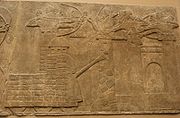
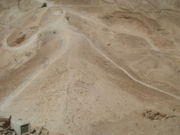
Battering ram
A battering ram is a siege engine originating in ancient times and designed to break open the masonry walls of fortifications or splinter their wooden gates...
s.
Centuries after they were employed in Assyria, the use of the siege tower spread throughout the Mediterranean. The biggest siege towers of antiquity, such as the Helepolis
Helepolis
Helepolis was an ancient siege engine invented by Polyidus of Thessaly and improved by Demetrius I of Macedon and Epimachus of Athens for the unsuccessful siege of Rhodes, based on an earlier, less massive design used against Salamis...
(meaning "The Taker of Cities") of the siege of Rhodes
Siege of Rhodes
The Siege of Rhodes was one of the most notable sieges of Antiquity, when Demetrius Poliorcetes, son of Antigonus I, besieged Rhodes in an attempt to break its alliance with Ptolemaic Egypt.- Background :...
in 305 BC, could be as high as 135 feet and as wide as 67.5 feet. Such large engines would require a rack and pinion
Rack and pinion
A rack and pinion is a type of linear actuator that comprises a pair of gears which convert rotational motion into linear motion. A circular gear called "the pinion" engages teeth on a linear "gear" bar called "the rack"; rotational motion applied to the pinion causes the rack to move, thereby...
to be moved effectively. It was manned by 200 soldiers and was divided into nine stories; the different levels housed various types of catapult
Onager (siege weapon)
The onager was a Roman siege engine, which derived its name from the kicking action of the machine, similar to that of an onager , it was created as a simpler, cheaper version of the ballista. The Onager is a type of catapult that uses torsional pressure, generally from twisted rope, to store...
s and ballista
Ballista
The ballista , plural ballistae, was an ancient missile weapon which launched a large projectile at a distant target....
e. Subsequent siege towers down through the centuries often had similar engines.
But this huge tower was defeated by the defenders by flooding the ground in front of the wall, creating a moat that caused the tower to get bogged in the mud. The siege of Rhodes illustrates the important point that the larger siege towers needed level ground. Many castles and hill-top towns and forts were virtually invulnerable to siege tower attack simply due to topography. Smaller siege towers might be used on top of siege-mounds, made of earth, rubble and timber mounds in order to overtop a defensive wall. The remains of such a siege-ramp at Masada
Masada
Masada is the name for a site of ancient palaces and fortifications in the South District of Israel, on top of an isolated rock plateau, or horst, on the eastern edge of the Judean Desert, overlooking the Dead Sea. Masada is best known for the violence that occurred there in the first century CE...
, for example, has survived almost 2,000 years and can still be seen today.
On the other hand, almost all the largest cities were on large rivers, or the coast, and so did have part of their circuit wall vulnerable to these towers. Furthermore, the tower for such a target might be prefabricated elsewhere and brought dismantled to the target city by water. In some rare circumstances, such towers were mounted on ships to assault the coastal wall of a city: at the siege of Cyzicus
Battle of Cyzicus (74 BC)
The Siege of Cyzicus was fought in 73 BC between armies of Mithridates VI of Pontus and the Roman-allied citizens of Cyzicus in Mysia and Roman Republican forces under Lucius Licinius Lucullus. It was a decisive Roman victory....
during the Third Mithridatic War
Third Mithridatic War
The Third Mithridatic War was the last and longest of three Mithridatic Wars fought between Mithridates VI of Pontus and his allies and the Roman Republic...
, for example, towers were used in conjunction with more conventional siege weapons.
One of the oldest references to the mobile siege tower in ancient China was ironically a written dialogue primarily discussing naval warfare
Naval warfare
Naval warfare is combat in and on seas, oceans, or any other major bodies of water such as large lakes and wide rivers.-History:Mankind has fought battles on the sea for more than 3,000 years. Land warfare would seem, initially, to be irrelevant and entirely removed from warfare on the open ocean,...
. In the Chinese
China
Chinese civilization may refer to:* China for more general discussion of the country.* Chinese culture* Greater China, the transnational community of ethnic Chinese.* History of China* Sinosphere, the area historically affected by Chinese culture...
Yuejueshu (Lost Records of the State of Yue
Yue (state)
Yue was a state in China which existed during the Spring and Autumn Period and the Warring States Period , in the modern province of Zhejiang. During the Spring and Autumn Period, its capital was in Guiji , near the modern city of Shaoxing...
) written by the later Han Dynasty
Han Dynasty
The Han Dynasty was the second imperial dynasty of China, preceded by the Qin Dynasty and succeeded by the Three Kingdoms . It was founded by the rebel leader Liu Bang, known posthumously as Emperor Gaozu of Han. It was briefly interrupted by the Xin Dynasty of the former regent Wang Mang...
author Yuan Kang in the year 52 AD, Wu Zixu
Wu Zixu
Wu Yun , better known by his style name Zixu , is the most famous ancestor of people with the surname of Wu . All branches of the Wu clans claim him as their "first ancestor"...
(526 BC-484 BC) purportedly
Interpolation (manuscripts)
An interpolation, in relation to literature and especially ancient manuscripts, is an entry or passage in a text that was not written by the original author...
discussed different ship types with King Helü of Wu
King Helü of Wu
King Helü of the state of Wu , a state in ancient China, was initially known as Prince Guang . He reigned towards the end of the Spring and Autumn Period.-Biography:...
(r. 514 BC-496 BC) while explaining military preparedness. Before labeling the types of warships used, Zixu said:
Medieval and later use
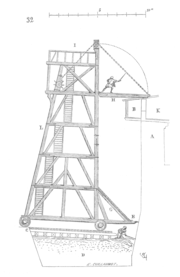
Byzantine Empire
The Byzantine Empire was the Eastern Roman Empire during the periods of Late Antiquity and the Middle Ages, centred on the capital of Constantinople. Known simply as the Roman Empire or Romania to its inhabitants and neighbours, the Empire was the direct continuation of the Ancient Roman State...
on the defensive, the use of siege towers reached its height during the medieval period. Siege towers were used when the Avar
Eurasian Avars
The Eurasian Avars or Ancient Avars were a highly organized nomadic confederacy of mixed origins. They were ruled by a khagan, who was surrounded by a tight-knit entourage of nomad warriors, an organization characteristic of Turko-Mongol groups...
s laid siege
Siege of Constantinople (626)
The Siege of Constantinople in 626 by the Avars, aided by large numbers of allied Slavs and the Sassanid Persians, ended in a strategic victory for the Byzantines...
unsuccessfully to Constantinople
Constantinople
Constantinople was the capital of the Roman, Eastern Roman, Byzantine, Latin, and Ottoman Empires. Throughout most of the Middle Ages, Constantinople was Europe's largest and wealthiest city.-Names:...
in 626, as the Chronicon Paschale
Chronicon Paschale
Chronicon Paschale is the conventional name of a 7th-century Greek Christian chronicle of the world...
recounts:
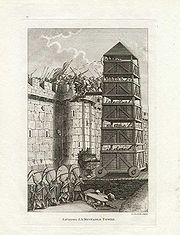
Moat
A moat is a deep, broad ditch, either dry or filled with water, that surrounds a castle, other building or town, historically to provide it with a preliminary line of defence. In some places moats evolved into more extensive water defences, including natural or artificial lakes, dams and sluices...
s with protection from the defenders (thus levelling the ground for the siege towers to be moved to the walls). However, the construction of a sloping talus
Talus (fortification)
The talus is an architectural feature of some late medieval castles, especially prevalent in crusader constructions. It consists of a sloping face at the base of a fortified wall. The slope acts as an effective defensive measure in two ways. First, conventional siege equipment is less effective...
at the base of a castle wall (as was common in Crusader
Crusades
The Crusades were a series of religious wars, blessed by the Pope and the Catholic Church with the main goal of restoring Christian access to the holy places in and near Jerusalem...
fortification) could have reduced the effectiveness of this tactic to an extent.
Siege towers also became more elaborate during the medieval period; at the Siege of Kenilworth Castle
Kenilworth Castle
Kenilworth Castle is located in the town of the same name in Warwickshire, England. Constructed from Norman through to Tudor times, the castle has been described by architectural historian Anthony Emery as "the finest surviving example of a semi-royal palace of the later middle ages, significant...
in 1266, for example, 200 archers and 11 catapults operated from a single tower. Even then, the siege lasted almost a year, making it the longest siege in English history
England in the Middle Ages
England in the Middle Ages concerns the history of England during the Medieval period — from the end of Roman rule in Britain through to the Early Modern period...
. They were not invulnerable either, as during the Fall of Constantinople
Fall of Constantinople
The Fall of Constantinople was the capture of the capital of the Byzantine Empire, which occurred after a siege by the Ottoman Empire, under the command of Ottoman Sultan Mehmed II, against the defending army commanded by Byzantine Emperor Constantine XI...
in 1453, Ottoman siege towers were sprayed by the defenders with Greek fire
Greek fire
Greek fire was an incendiary weapon used by the Byzantine Empire. The Byzantines typically used it in naval battles to great effect as it could continue burning while floating on water....
.
Siege towers became vulnerable and obsolete with the development of large cannon
Cannon
A cannon is any piece of artillery that uses gunpowder or other usually explosive-based propellents to launch a projectile. Cannon vary in caliber, range, mobility, rate of fire, angle of fire, and firepower; different forms of cannon combine and balance these attributes in varying degrees,...
. They had only ever existed to get assaulting troops over high walls and large cannon also made high walls obsolete as fortification took a new direction. However, later constructions known as battery-towers took on a similar role in the gunpowder
Gunpowder
Gunpowder, also known since in the late 19th century as black powder, was the first chemical explosive and the only one known until the mid 1800s. It is a mixture of sulfur, charcoal, and potassium nitrate - with the sulfur and charcoal acting as fuels, while the saltpeter works as an oxidizer...
age; like siege-towers, these were built out of wood on site for mounting siege artillery
Artillery
Originally applied to any group of infantry primarily armed with projectile weapons, artillery has over time become limited in meaning to refer only to those engines of war that operate by projection of munitions far beyond the range of effect of personal weapons...
. One of these was built by the Russian
Russians
The Russian people are an East Slavic ethnic group native to Russia, speaking the Russian language and primarily living in Russia and neighboring countries....
military engineer
Military engineer
In military science, engineering refers to the practice of designing, building, maintaining and dismantling military works, including offensive, defensive and logistical structures, to shape the physical operating environment in war...
Ivan Vyrodkov
Ivan Vyrodkov
Ivan Grigoryevich Vyrodkov was a Russian military engineer, inventor, and diak.Ivan Vyrodkov's name was first mentioned in 1538. It is known that he participated in Ivan the Terrible's military campaigns against Kazan, during the Russo-Kazan Wars. In 1551, Ivan Vyrodkov was in charge of the...
during the siege of Kazan in 1552 (as part of the Russo-Kazan Wars
Russo-Kazan Wars
thumb|300px|[[St. Basil's Cathedral]] is a monument to the Russian conquest of Kazan in 1552.The Russo-Kazan Wars was a series of wars fought between the Khanate of Kazan and Muscovite Russia from 1438, until Kazan was finally captured by Ivan the Terrible and absorbed into Russia in 1552.- Wars of...
), and could hold ten large-calibre cannon and 50 lighter cannons. Likely, it was a development of the gulyay-gorod
Gulyay-gorod
Gulyay-gorod, also guliai-gorod, gulay-gorod, literally: "wandering town"), was a mobile fortification used by the Russian army between the 15th and the 17th centuries....
idea (that is a mobile fortification assembled on wagons or sleds from prefabricated wall-sized shields with holes for cannons). Later battery towers were often used by the Ukrainian
Ukraine
Ukraine is a country in Eastern Europe. It has an area of 603,628 km², making it the second largest contiguous country on the European continent, after Russia...
Cossacks.
Modern parallels
On 1 March 2007, police officers were lifted to the upper levels of the building using small boom cranes in a manner similar to siege towers to enter UngdomshusetUngdomshuset
Ungdomshuset was the popular name of the building formally named Folkets Hus located on Jagtvej 69 in Nørrebro, Copenhagen, which functioned as an underground scene venue for music and rendezvous point for varying autonomen and leftist groups from 1982 until 2007 when—after prolonged conflict—it...
in Copenhagen
Copenhagen
Copenhagen is the capital and largest city of Denmark, with an urban population of 1,199,224 and a metropolitan population of 1,930,260 . With the completion of the transnational Øresund Bridge in 2000, Copenhagen has become the centre of the increasingly integrating Øresund Region...
, Denmark
Denmark
Denmark is a Scandinavian country in Northern Europe. The countries of Denmark and Greenland, as well as the Faroe Islands, constitute the Kingdom of Denmark . It is the southernmost of the Nordic countries, southwest of Sweden and south of Norway, and bordered to the south by Germany. Denmark...
. The officers were placed in containers which were lifted to the windows, thus enabling the police to gain access to the illegally occupied structure.

